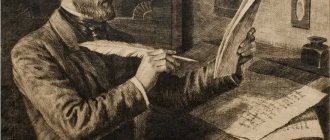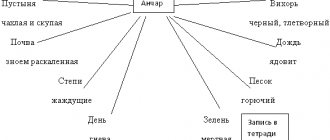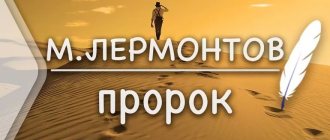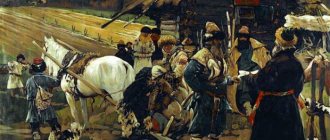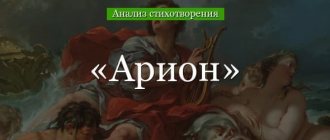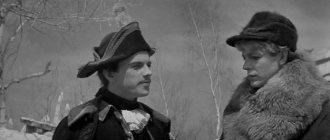"Liberty"
"Liberty" (1817), one of the remarkable works of Russian political poetry, echoes Radishchev's ode of the same name, although Pushkin's political views are more moderate. The poet praises the law that limits autocracy, asserts the equality before the law of the king and the people, ensuring Liberty, i.e. Freedom. By observing the law, the king ceases to be a tyrant, and the people receive real rights. Violation of the law both on the part of the king and on the part of the people leads to crimes. The ode contains political allusions to events of the recent past: the fall of Napoleon, the assassination of Paul I, organized with the knowledge of his son Alexander, etc.
Report: Pushkin’s life in St. Petersburg from 1817 to 1820
After graduating from the Lyceum, Pushkin was enrolled as a collegiate secretary at the College of Foreign Affairs and moved to St. Petersburg, where he lived almost continuously until 1820.
He liked everything in St. Petersburg, except for two things: life in his parents' house and service.
The Pushkins always lived uncomfortably, and in Moscow they generally led a nomadic lifestyle: they moved from place to place every year.
Alexander’s parents did not strive to equip the house, create comfort and maintain order. Father, bel esprit - a brilliant wit in his youth - over the years he lost his former wit and “guards”.
Mother never did housework; she didn’t care what was happening in the house: she could wander around the dimly lit rooms all day and not pay attention to the dried plates with yesterday’s dinner on the table.
If we add to this that Alexander was an unloved child - not very beautiful, with the wrong character and who did not live up to expectations, then it becomes clear why Pushkin preferred to spend significant time outside the home. And he couldn’t invite anyone home - the chaos was simply depressing, and the sensitive Pushkin tried to avoid negative emotions.
Pushkin skimped on his work, as they said then. And what was a genius to do in a public place? Just to be present—his thoughts were always far away. And he went where his thoughts were and where his feelings led.
And his salary was small - only seven hundred rubles a year. And, if we add to this that Pushkin wrote a request for leave several times a year, it becomes clear that this work did not bring much income.
There was also no need to expect money from my parents: in terms of clothes, I was content with what I had. He entertained himself mainly in the houses of his wealthier friends with their money.
But this did not burden Pushkin at all - caring about his daily bread and money did not interest him.
Pushkin inherited a lot from his grandfather, and, in particular, increased sensuality. Even at the Lyceum he was considered the most sensual of the boys.
Over the years, the temperament received from his African ancestor took its toll: Pushkin, finding himself in St. Petersburg with its temptations, plunged headlong into life, love and revelry in the circle of the then “golden youth”.
And his sensual preferences were supported by the noble licentiousness of morals: kurtags, visiting salons, cards and heartfelt hobbies were then a common pastime. In addition, he was an expert in poetry, which corrupted his imagination.
And Pushkin, the “cheerful, young epicurean,” has fun from the heart: he participates in merry parties, drinking bouts and obscene performances (“The Destruction of Sodom and Gomorrah,” “The Expulsion of Adam and Eve”). Falls in love and indulges in numerous love pleasures. It was during this time of debauchery that Pushkin wrote his “Gavriliad”.
And Pushkin’s frequent “loves” gave rise to numerous lyrical works dedicated to the objects of love: Lida, Nadenka, Laisa, Olga, Dorida.
Pushkin’s friend at the time, Vsevolzhsky, gave this debauchery some organization by uniting the “golden youth” into the “Green Lamp” society. Disputes begin, influenced by moderately radical ideas.
It was here, between feasts and entertainment, that Pushkin created works in which he “sang freedom to the world” and believed in a bright future: “Liberty”, “To Chaadaev”, “Fairy Tales”, “Village” and others.
At the same time, Pushkin begins to gravitate towards romanticism and expressive emotionality. “The Triumph of Bacchus”, “There, by the forest, beyond the nearby valley”, “To Zhukovsky” were written in this spirit.
This time is the time of brilliant epigrams in which he brands the tsar and his entourage: he calls Alexander I a “nomadic despot”, Arakcheev - “an oppressor of all Russia”.
The Decembrists will borrow many epigrams from Pushkin for propaganda purposes - they will be so good. And after a small libel against Prince Golitsyn, known as “Press, for God’s sake, on him from all sides...”, he acquired another enemy - it was Golitsyn who would insist on Pushkin’s exile to Spain.
These works were not published, but were transmitted handwritten. At that time, many were fond of writing epigrams. And most of the epigrams that circulated around St. Petersburg did not belong to Pushkin, but were only attributed to him. And this later, before exile, would serve him badly: at the police station, where he was invited for a conversation, an entire closet was filled with epigrams.
While still at the Lyceum, Pushkin decided to write a poem. The plot is ordinary: a beautiful bride is kidnapped from a wedding feast by an evil Sorcerer. And, naturally, the groom Ruslan goes to look for his beloved.
Pushkin chooses an unusual writing style: lively, witty - a real conversation with the reader. Nobody wrote like that then, and serious controversy began around the poem.
Some admired the beautiful Russian language and the smoothness of the narrative. Someone found a lot of bad taste in the poem and called it “a man in bast shoes” in a noble assembly.
In the summer of 1820, a separate edition of the poem was published. “Ruslan and Lyudmila” is one of the first works by Pushkin to gain fame and recognition in the West.
By the middle of 1820, the clouds had already thickened over Pushkin’s head: it was firmly decided that he should be exiled, the only thing that was being decided was where. And soon Pushkin will be forced to leave his beloved St. Petersburg and begin a new period of his life - unusual, romantic and fruitful, as befits a true genius.
"Village"
“Village” (1819) reflected the poet’s anti-serfdom sentiments. The poem has three parts, differing in vocabulary, rhythmic and intonation patterns, visual means, and ideological orientation. The poem begins with an idyllic image of rural nature, in the bosom of which the poet dreams of immersing himself in the study of the works of great thinkers. The traditions of sentimental literature are noticeably felt in this part. The next part is the author’s passionate journalistic reasoning about the “wild lordship”, which appropriated “with a violent vine, the labor, property, and time of the farmer,” and “meager slavery.” The ending of the poem - a rhetorical question-appeal - expresses the author's hope for the abolition of slavery. Poetics is based on the principle of contrast; the poem is characterized by an upbeat tone, oratorical structure of speech, and the use of Slavicisms and ancient images.
Poem "Ruslan and Lyudmila"
The poem took a long time to create: Pushkin conceived it while still at the Lyceum, and finished it only in 1820.
The poem had nothing to do with politics, it was a love story.
However, the work itself turned out to be innovative and rebellious in the world of literature of that time.
Pushkin was able to change traditions and create a narrative in a slightly different, lighter genre than had been done before in similar works.
The release of the poem caused a lot of noise in literary circles. Readers were delighted with her and bought books. Critics unleashed a barrage of objections on the poet. The poet at this time had already been sent into exile to the south, and was unable to gain recognition.
We can say that Pushkin retreated from tradition and revolutionized the literary genre.
In conclusion, we can say that during the first Petersburg period (from 1817 to 1820), Alexander Pushkin truly believed in the idea of freedom, which is why it was so sincerely expressed in his works.
Source
"To Chaadaev"
“To Chaadaev” (1818) was written in the form of an address to a friend. The composition is three-part: the first part is a memory of “youthful amusements” and hopes deceived by Alexander’s reality, the second speaks of the hero’s desire for “light freedom”, in the third, in the future, images of those whose names will go down in the history of the liberation struggle of Russia appear. The main idea of the poem is a call to contemporaries to dedicate “the beautiful impulses of their souls” to the Fatherland. The poem called for a feat, which was perceived as a revolutionary action. The socio-journalistic and civil aspects are combined in the poem with the intimate and lyrical; Pushkin uses words of high style, socio-political terms used in the speech of noble revolutionaries; the syntax is characterized by harmony, simplicity, and energy in the presentation of thoughts.
Petersburg creative period (1817–1820)
Petersburg creative period (1817–1820)
Full of creative ideas, Pushkin entered a new era of his life. Karamzin, Zhukovsky, Batyushkov, Vyazemsky predicted poetic glory for him. The poet is a participant in the ending Arzamas and is still an opponent of the Conversation of Lovers of the Russian Word. However, he takes a closer look at her and becomes close to his former literary antagonists - Griboyedov, Katenin, Shakhovsky. Pushkin wants, as he later explained in a letter to Katenin, to avoid “one-sidedness in literary opinions,” for any “one-sidedness is the destruction of thought.”
If Lyceum lyricism is associated with the assimilation of the poetic principles of the psychological movement in Russian romanticism, then in the St. Petersburg period the orientation partly changes, and Pushkin directs his gaze to the newly emerging civil, or social, movement of Russian romanticism. Many friendly and creative threads connect him with the Welfare Union and the societies and circles close to it - the Free Society of Lovers of Russian Literature, the “Green Lamp”, N.I.’s home circle. Turgenev. In The Green Lamp, political and religious freethinking is combined with erotic and bacchanalian poetic motifs, and in Turgenev’s circle, attitudes toward social and philosophical lyricism prevailed. In societies and circles, the foundations of civic poetry are developed, the typological features of which are well known - preference for philosophical and journalistic themes and genres over themes and genres of intimate lyrics, appeal to heroic and tragic episodes of national history, directly related to modernity, instructiveness (historical “lessons” ), installation on an oratorical, declamatory style, allusions and the widespread use of metaphorical signal words.
Mikhailovskoe
The return to his father's house turned into another exile for the poet. His own father supervised his own son, and such a life for the freedom-loving Alexander Sergeevich was simply unbearable. As a result of a serious conflict with his father, the entire family, including mother, brother and sister, left Mikhailovskoye and moved to the capital. Pushkin was left alone in the company of Arina Rodionovna.
Despite the depressed state and despondency, during the two years spent in Mikhailovsky, the poet worked hard and fruitfully. Pushkin was alien to the usual “landowner” amusements. He read a lot, filling in the gaps in his home and lyceum education. The poet constantly ordered books from the capital, which were inspected by the police, his letters were also opened and read.
Uprising of December 14, 1825
Under these conditions, “Caucasian Prisoner”, “Boris Godunov”, “Count Nulin”, many poems were written (including “Winter Morning”, “Napoleon”, “Song of the Prophetic Oleg”), a number of articles, several chapters of “Eugene Onegin".
It is known that during his exile in Mikhailovsky, Pushkin’s longtime and best friend from the Lyceum, Pushchin, came to see him. The poet also communicated with the Osipov family - landowners who owned the neighboring village of Trigorskoye.
The news of the uprising on December 14, 1825, in the organization of which many of the poet’s friends and acquaintances participated, took Alexander Sergeevich by surprise. The likelihood that the disgraced Pushkin would have taken part in the uprising was so great that his friends deceived him by giving the wrong date for the impending coup and preserving the great poet for the Motherland. Many participants in the rebellion were exiled to Siberia, and the main instigators were hanged.
"Contemporary"
Under these conditions, he finds a way out that solves many problems at once. He founded a magazine called Sovremennik. It published works by Nikolai Gogol, Alexander Turgenev, V. A. Zhukovsky, P. A. Vyazemsky. Nevertheless, the magazine did not have reader success: the Russian public still had to get used to the new type of serious periodical devoted to topical problems, interpreted by necessity with hints. The magazine only had 600 subscribers, which made it ruinous for the publisher, since neither printing costs nor staff fees were covered. Pushkin fills more than half of the last two volumes of Sovremennik with his works, mostly anonymous. The novel “The Captain's Daughter” was finally published in the fourth volume of Sovremennik. The same aspiration for future generations inspired Pushkin’s final poem, going back to Horace, “I erected a monument to myself not made by hands...” (August 1836).
Duality
In many works of A. S. Pushkin, Petersburg is glorified. The famous lines from the poem “The Bronze Horseman” express the author’s attitude: “I love you, Peter’s creation.”
But St. Petersburg is assessed by A. S. Pushkin ambiguously. The poem “Lush City, Poor City” (1828) says that in St. Petersburg there is a “spirit of bondage” and there is “boredom and cold” there.
A.S. Pushkin describes not only majestic Petersburg, but also low Petersburg.
This contradictory attitude towards St. Petersburg is due to the fact that A.S. Pushkin, after the Southern exile and the Northern exile, returned to St. Petersburg (1827) and witnessed a completely different situation. A.S. Pushkin felt unfree.
Read also
Petersburg Protocol
St. Petersburg Protocol In resolving the Greek issue, Emperor Nikolai Pavlovich went to meet Britain, eager to make friends. On March 23, 1826, in St. Petersburg, Russian and English representatives signed a protocol providing for the actual restoration of the Greek
St. Petersburg University
St. Petersburg University During the accession of Nicholas I, St. Petersburg University actually did not function. The Emperor immediately drew attention to the sad state of the capital's university. In November 1830, the buildings of the Twelve Colleges were transferred to him. For his
Petersburg tract
St. Petersburg tract The St. Petersburg tract, along which Tatyana’s cart dragged itself, was one of the first to be paved with cobblestones. This happened just ten years before Tatyana’s trip to Moscow. A snow-covered forest stretched along the highway for dozens of miles. Only occasionally came across
St. Petersburg period of Ukrainian cultural activity
The St. Petersburg period of Ukrainian cultural activity Only after the Crimean War, a valiant war for the army, in which all the peoples of Russia fought equally and which revealed the shortcomings of the regime, did the political “thaw” begin. Even the most severely punished member
The late period of Murillo's work
6. Late period of Murillo's work During the heyday of his style, Murillo achieved undeniable heights in the execution of portrait images. His everyday paintings are less accurate than Velazquez's, but more emotional. Murillo's students made significant contributions to Spanish
The late period of Rembrandt's work
7. The late period of Rembrandt’s work In the 40s, the main direction of Rembrandt’s work and his characteristic style were finally formed. He increasingly paints portraits of older people with careful detailing of facial features and lighting, often in full body. Landscape and
Petersburg style
St. Petersburg style And again I had a strong feeling that Leningrad was somehow different from the rest of the Soviet Union, that it felt at a level somewhat higher than average. Alexander Vert. Five days in besieged Leningrad What happened in St. Petersburg
Petersburg myth based on Falcone's project
Petersburg myth according to Falconet's design In 1770, a serious architectural reason for comparing the two reigns arose, associated with the work of Etienne Falconet on the design of the equestrian statue of Peter. At the end of September, a huge Thunder Stone, designed as a pedestal for a statue,

